
我想为我的简历定义一种特殊的分段类型。但我遇到了一个自己无法解决的问题。我得到了以下代码,它生成了我想要的带有颜色渐变的分段标题。将它用于第一节效果很好,但对于后续部分,我得到的结果总是与第一节中写的结果相同。以下代码将说明该问题:
\documentclass{article}
\usepackage{tikz}
\usetikzlibrary{fadings,patterns,positioning,fit}
\tikzset{
zero sep/.style = {inner sep=0pt, outer sep=0pt},
}
\begin{document}
\newsavebox{\tempbox}
\newcommand\tikzsection[1]{%
\begin{tikzfadingfrompicture}[name=tikzsection]
\node [minimum width=50mm, minimum height=2.5mm, fill=white, zero sep] (box node) {};
\node (text node) [text=white, right=10pt of box node.east, anchor=west, zero sep] {\normalfont \Large \bfseries #1};
\node [fit=(box node.north west) (text node.south east) (text node.north west) (box node.south east)] {};
\end{tikzfadingfrompicture}
\begin{lrbox}{\tempbox}%
\begin{tikzpicture}
\node [text width=50mm, minimum height=2.5mm, fill=white, zero sep] (boxnode) {};
\node [text=white, right=10pt of boxnode.east, anchor=west, zero sep] (textnode) {\normalfont \Large \bfseries #1};
\node (fitnode) [fit=(boxnode.north west) (textnode.south east) (textnode.north west) (boxnode.south east)] {};
\shade[path fading=tikzsection, fit fading=false,left color=blue, right color=black]
(fitnode.north west) rectangle (fitnode.south east);
\end{tikzpicture}%
\end{lrbox}
% Now we use the fading in another picture:
\section{\usebox\tempbox{}}%
}
\tikzsection{First section}
Some text
\tikzsection{Secoooooond section}
Some text
\tikzsection{Short}
Some text
\end{document}
有人能帮我找出这里出了什么问题吗?为什么标题为“第二部分”的部分被渲染为“第一部分”?

\listfiles给出以下列表:
- article.cls 2007/10/19 v1.4h 标准 LaTeX 文档类
- size10.clo 2007/10/19 v1.4h 标准 LaTeX 文件(尺寸选项)
- tikz.sty 2013/12/13 v3.0.0(rcs-修订版 1.142)
- pgf.sty 2013/12/18 v3.0.0(rcs-修订版 1.14)
- pgfrcs.sty 2013/12/20 v3.0.0 (rcs-修订版 1.28)
- everyshi.sty 2001/05/15 v3.00 EveryShipout 包 (MS)
- pgfrcs.code.tex pgfcore.sty 2010/04/11 v3.0.0 (rcs-修订版 1.7)
- graphicx.sty 1999/02/16 v1.0f 增强型 LaTeX 图形 (DPC、SPQR)
- keyval.sty 1999/03/16 v1.13 键=值解析器(DPC)
- graphics.sty 2009/02/05 v1.0o 标准 LaTeX 图形 (DPC,SPQR)
- trig.sty 1999/03/16 v1.09 正弦余弦正切 (DPC)
- graphics.cfg 2010/04/23 v1.9 TeX Live 的图形配置
- xetex.def 2013/04/29 v0.96 LaTeX 颜色/图形驱动程序,适用于 XeTeX (RRM/JK)
- pgfsys.sty 2013/11/30 v3.0.0(rcs-修订版 1.47)
- pgfsyssoftpath.code.tex 2013/09/09(rcs-修订版 1.9)
- pgfsysprotocol.code.tex 2006/10/16 (rcs-修订版 1.4)
- xcolor.sty 2007/01/21 v2.11 LaTeX 颜色扩展
- color.cfg 2007/01/18 v1.5 teTeX/TeXLive 的颜色配置
- pgfcomp-version-0-65.sty 2007/07/03 v3.0.0 (rcs-修订版 1.7)
- pgfcomp-version-1-18.sty 2007/07/23 v3.0.0 (rcs-修订版 1.1)
- pgffor.sty 2013/12/13 v3.0.0 (rcs-修订版 1.25)
答案1
这解决方法对于 XeLaTeX :每个使用不同的名称tikzfadingfrompicture!
第三版
(与 XeLaTeX 配合使用,具有与第二版相同的功能。)
\documentclass{article}
\usepackage{tikz}
\usetikzlibrary{fadings,patterns,positioning,fit,calc}
\tikzset{
zero sep/.style = {inner sep=0pt, outer sep=0pt},
}
\newcommand\tikzsection[1]{%
\pgfmathsetmacro\randref{rand}
\begin{tikzfadingfrompicture}[name=tikzsection \randref]
\node[fill=white,anchor=south east,zero sep,minimum width=5cm,minimum height=2.5mm] (box node){};
\node [text=white,anchor=base west,text depth=5pt,text height=12pt,zero sep,
font=\normalfont\Large\bfseries,right=10pt of box node,
text width=5.9cm,align=left] (text node) {#1};
\node [fit={(box node)(text node)
},zero sep] (myfit) {};
\path let \p1=(myfit.south west), \p2=(myfit.north east), \n1={\x2-\x1}, \n2={\y2-\y1} in
\pgfextra{\xdef\lenx{\n1} \xdef\leny{\n2}};
\end{tikzfadingfrompicture}
\section[#1]{%
\begin{tikzpicture}[baseline=.5*5pt-.5*12pt]
\path[path fading=tikzsection \randref, fit fading=false,left color=blue, right color=black]
(-.5*\lenx,-.5*\leny) rectangle ++(\lenx,\leny);
\end{tikzpicture}
}
}
\pagestyle{empty}
\begin{document}
\tikzsection{First section}
Some text
\tikzsection{Secoooooond segtion}
Some text
\tikzsection{Short}
Some text
\end{document}
第二版
这是一个新版本:
- 使用正确的 tikz 褪色位置,
- 没有保存框,
- 关心标题的深度和高度,
- 正确对齐基线,
- 标题(和褪色)的长度固定(15厘米)。

\documentclass{article}
\usepackage[rgb]{xcolor}
\usepackage{tikz}
\usetikzlibrary{fadings,patterns,positioning,fit,calc}
\tikzset{
zero sep/.style = {inner sep=0pt, outer sep=0pt},
}
\newcommand\tikzsection[1]{%
\pgfmathsetmacro\randref{rand}
\begin{tikzfadingfrompicture}[name=tikzsection \randref]
\fill[white] (0,0) rectangle +(5cm,2.5mm);
\node [text=white,anchor=base west,text depth=5pt,text height=12pt,zero sep,font=\normalfont\Large\bfseries,
text width=10cm,align=left]
(text node) at (5cm+10pt,0) {#1};
\node [fit={(0,0)(text node)},zero sep] (myfit) {};
\path let \p1=(myfit.south west), \p2=(myfit.north east), \n1={\x2-\x1}, \n2={\y2-\y1} in
\pgfextra{\xdef\lenx{\n1} \xdef\leny{\n2}};
\end{tikzfadingfrompicture}
\typeout{lenx:\lenx}
\typeout{leny:\leny}
\section[#1]{%
\begin{tikzpicture}[baseline=.5*5pt-.5*12pt]
\path[path fading=tikzsection \randref, fit fading=false,left color=blue, right color=black]
(-.5*\lenx,-.5*\leny) rectangle ++(\lenx,\leny);
\end{tikzpicture}
}
}
\begin{document}
\tikzsection{First section}
Some text
\tikzsection{Secoooooond segtion}
Some text
\tikzsection{Short}
Some text
\end{document}
第一个版本
\documentclass{article}
\usepackage{tikz}
\usetikzlibrary{fadings,patterns,positioning,fit}
\tikzset{
zero sep/.style = {inner sep=0pt, outer sep=0pt},
}
\begin{document}
\newsavebox{\tempbox}
\newcommand\tikzsection[1]{%
\begin{tikzfadingfrompicture}[name=tikzsection #1]
\node [minimum width=50mm, minimum height=2.5mm, fill=white, zero sep] (box node) {};
\node (text node) [text=white, right=10pt of box node.east, anchor=west, zero sep] {\normalfont \Large \bfseries #1};
\node [fit=(box node.north west) (text node.south east) (text node.north west) (box node.south east)] {};
\end{tikzfadingfrompicture}
\begin{lrbox}{\tempbox}%
\begin{tikzpicture}
\node [text width=50mm, minimum height=2.5mm, fill=white, zero sep] (boxnode) {};
\node [text=white, right=10pt of boxnode.east, anchor=west, zero sep] (textnode) {\normalfont \Large \bfseries #1};
\node (fitnode) [fit=(boxnode.north west) (textnode.south east) (textnode.north west) (boxnode.south east)] {};
\shade[path fading=tikzsection #1, fit fading=false,left color=blue, right color=black]
(fitnode.north west) rectangle (fitnode.south east);
\end{tikzpicture}%
\end{lrbox}
% Now we use the fading in another picture:
\section[#1]{\usebox\tempbox{}}%
}
\tikzsection{First section}
Some text
\tikzsection{Secoooooond section}
Some text
\tikzsection{Short}
Some text
\end{document}


